Zongwei Li
Hunyuan-TurboS: Advancing Large Language Models through Mamba-Transformer Synergy and Adaptive Chain-of-Thought
May 21, 2025Abstract:As Large Language Models (LLMs) rapidly advance, we introduce Hunyuan-TurboS, a novel large hybrid Transformer-Mamba Mixture of Experts (MoE) model. It synergistically combines Mamba's long-sequence processing efficiency with Transformer's superior contextual understanding. Hunyuan-TurboS features an adaptive long-short chain-of-thought (CoT) mechanism, dynamically switching between rapid responses for simple queries and deep "thinking" modes for complex problems, optimizing computational resources. Architecturally, this 56B activated (560B total) parameter model employs 128 layers (Mamba2, Attention, FFN) with an innovative AMF/MF block pattern. Faster Mamba2 ensures linear complexity, Grouped-Query Attention minimizes KV cache, and FFNs use an MoE structure. Pre-trained on 16T high-quality tokens, it supports a 256K context length and is the first industry-deployed large-scale Mamba model. Our comprehensive post-training strategy enhances capabilities via Supervised Fine-Tuning (3M instructions), a novel Adaptive Long-short CoT Fusion method, Multi-round Deliberation Learning for iterative improvement, and a two-stage Large-scale Reinforcement Learning process targeting STEM and general instruction-following. Evaluations show strong performance: overall top 7 rank on LMSYS Chatbot Arena with a score of 1356, outperforming leading models like Gemini-2.0-Flash-001 (1352) and o4-mini-2025-04-16 (1345). TurboS also achieves an average of 77.9% across 23 automated benchmarks. Hunyuan-TurboS balances high performance and efficiency, offering substantial capabilities at lower inference costs than many reasoning models, establishing a new paradigm for efficient large-scale pre-trained models.
Facial Recognition Leveraging Generative Adversarial Networks
May 17, 2025



Abstract:Face recognition performance based on deep learning heavily relies on large-scale training data, which is often difficult to acquire in practical applications. To address this challenge, this paper proposes a GAN-based data augmentation method with three key contributions: (1) a residual-embedded generator to alleviate gradient vanishing/exploding problems, (2) an Inception ResNet-V1 based FaceNet discriminator for improved adversarial training, and (3) an end-to-end framework that jointly optimizes data generation and recognition performance. Experimental results demonstrate that our approach achieves stable training dynamics and significantly improves face recognition accuracy by 12.7% on the LFW benchmark compared to baseline methods, while maintaining good generalization capability with limited training samples.
SCALM: Detecting Bad Practices in Smart Contracts Through LLMs
Feb 04, 2025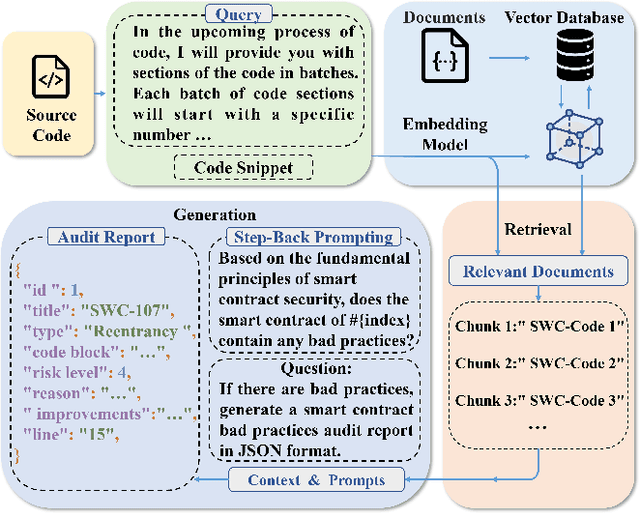
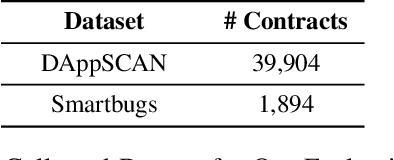
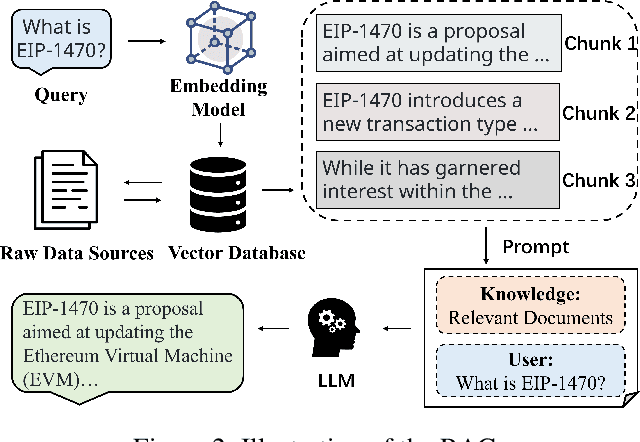
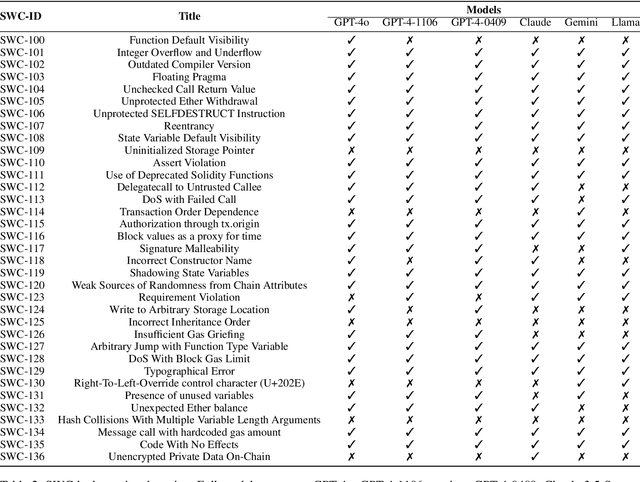
Abstract:As the Ethereum platform continues to mature and gain widespread usage, it is crucial to maintain high standards of smart contract writing practices. While bad practices in smart contracts may not directly lead to security issues, they do elevate the risk of encountering problems. Therefore, to understand and avoid these bad practices, this paper introduces the first systematic study of bad practices in smart contracts, delving into over 35 specific issues. Specifically, we propose a large language models (LLMs)-based framework, SCALM. It combines Step-Back Prompting and Retrieval-Augmented Generation (RAG) to identify and address various bad practices effectively. Our extensive experiments using multiple LLMs and datasets have shown that SCALM outperforms existing tools in detecting bad practices in smart contracts.
DiffGraph: Heterogeneous Graph Diffusion Model
Jan 04, 2025



Abstract:Recent advances in Graph Neural Networks (GNNs) have revolutionized graph-structured data modeling, yet traditional GNNs struggle with complex heterogeneous structures prevalent in real-world scenarios. Despite progress in handling heterogeneous interactions, two fundamental challenges persist: noisy data significantly compromising embedding quality and learning performance, and existing methods' inability to capture intricate semantic transitions among heterogeneous relations, which impacts downstream predictions. To address these fundamental issues, we present the Heterogeneous Graph Diffusion Model (DiffGraph), a pioneering framework that introduces an innovative cross-view denoising strategy. This advanced approach transforms auxiliary heterogeneous data into target semantic spaces, enabling precise distillation of task-relevant information. At its core, DiffGraph features a sophisticated latent heterogeneous graph diffusion mechanism, implementing a novel forward and backward diffusion process for superior noise management. This methodology achieves simultaneous heterogeneous graph denoising and cross-type transition, while significantly simplifying graph generation through its latent-space diffusion capabilities. Through rigorous experimental validation on both public and industrial datasets, we demonstrate that DiffGraph consistently surpasses existing methods in link prediction and node classification tasks, establishing new benchmarks for robustness and efficiency in heterogeneous graph processing. The model implementation is publicly available at: https://github.com/HKUDS/DiffGraph.
Hunyuan-Large: An Open-Source MoE Model with 52 Billion Activated Parameters by Tencent
Nov 05, 2024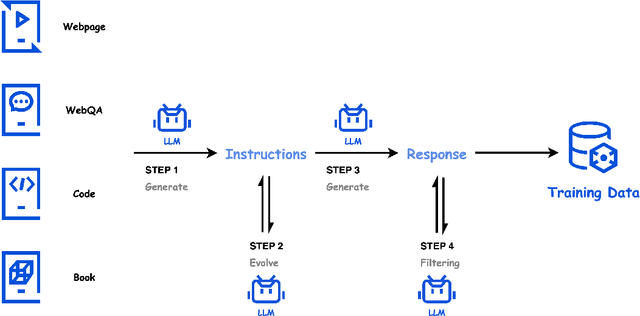
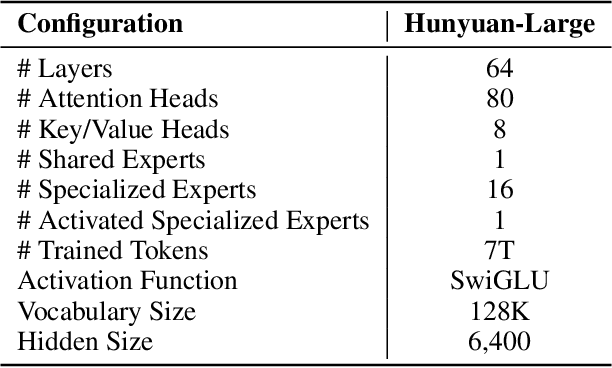
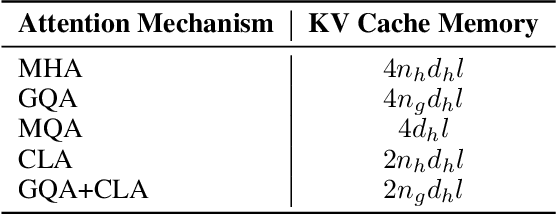
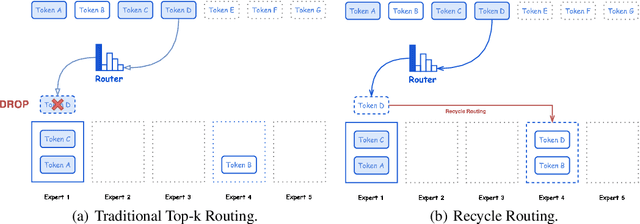
Abstract:In this paper, we introduce Hunyuan-Large, which is currently the largest open-source Transformer-based mixture of experts model, with a total of 389 billion parameters and 52 billion activation parameters, capable of handling up to 256K tokens. We conduct a thorough evaluation of Hunyuan-Large's superior performance across various benchmarks including language understanding and generation, logical reasoning, mathematical problem-solving, coding, long-context, and aggregated tasks, where it outperforms LLama3.1-70B and exhibits comparable performance when compared to the significantly larger LLama3.1-405B model. Key practice of Hunyuan-Large include large-scale synthetic data that is orders larger than in previous literature, a mixed expert routing strategy, a key-value cache compression technique, and an expert-specific learning rate strategy. Additionally, we also investigate the scaling laws and learning rate schedule of mixture of experts models, providing valuable insights and guidances for future model development and optimization. The code and checkpoints of Hunyuan-Large are released to facilitate future innovations and applications. Codes: https://github.com/Tencent/Hunyuan-Large Models: https://huggingface.co/tencent/Tencent-Hunyuan-Large
RecDiff: Diffusion Model for Social Recommendation
Jun 01, 2024



Abstract:Social recommendation has emerged as a powerful approach to enhance personalized recommendations by leveraging the social connections among users, such as following and friend relations observed in online social platforms. The fundamental assumption of social recommendation is that socially-connected users exhibit homophily in their preference patterns. This means that users connected by social ties tend to have similar tastes in user-item activities, such as rating and purchasing. However, this assumption is not always valid due to the presence of irrelevant and false social ties, which can contaminate user embeddings and adversely affect recommendation accuracy. To address this challenge, we propose a novel diffusion-based social denoising framework for recommendation (RecDiff). Our approach utilizes a simple yet effective hidden-space diffusion paradigm to alleivate the noisy effect in the compressed and dense representation space. By performing multi-step noise diffusion and removal, RecDiff possesses a robust ability to identify and eliminate noise from the encoded user representations, even when the noise levels vary. The diffusion module is optimized in a downstream task-aware manner, thereby maximizing its ability to enhance the recommendation process. We conducted extensive experiments to evaluate the efficacy of our framework, and the results demonstrate its superiority in terms of recommendation accuracy, training efficiency, and denoising effectiveness. The source code for the model implementation is publicly available at: https://github.com/HKUDS/RecDiff.
LanguageBind: Extending Video-Language Pretraining to N-modality by Language-based Semantic Alignment
Oct 14, 2023
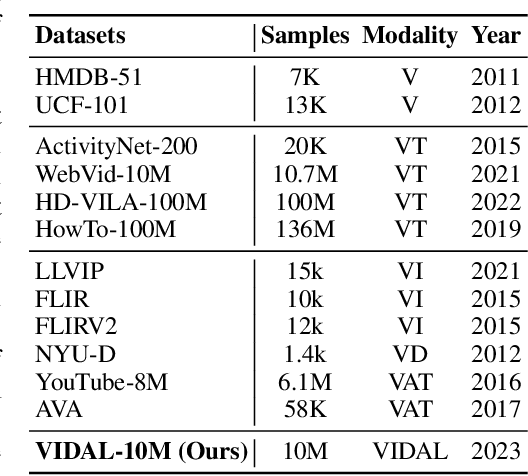
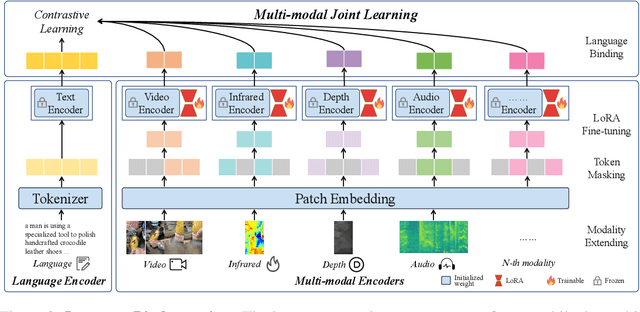

Abstract:The video-language (VL) pretraining has achieved remarkable improvement in multiple downstream tasks. However, the current VL pretraining framework is hard to extend to multiple modalities (N modalities, N>=3) beyond vision and language. We thus propose LanguageBind, taking the language as the bind across different modalities because the language modality is well-explored and contains rich semantics. Specifically, we freeze the language encoder acquired by VL pretraining, then train encoders for other modalities with contrastive learning. As a result, all modalities are mapped to a shared feature space, implementing multi-modal semantic alignment. While LanguageBind ensures that we can extend VL modalities to N modalities, we also need a high-quality dataset with alignment data pairs centered on language. We thus propose VIDAL-10M with Video, Infrared, Depth, Audio and their corresponding Language, naming as VIDAL-10M. In our VIDAL-10M, all videos are from short video platforms with complete semantics rather than truncated segments from long videos, and all the video, depth, infrared, and audio modalities are aligned to their textual descriptions. After pretraining on VIDAL-10M, we outperform ImageBind by 5.8% R@1 on the MSR-VTT dataset with only 15% of the parameters in the zero-shot video-text retrieval task. Beyond this, our LanguageBind has greatly improved in the zero-shot video, audio, depth, and infrared understanding tasks. For instance, LanguageBind surpassing InterVideo by 1.9% on MSR-VTT, 8.8% on MSVD, 6.3% on DiDeMo, and 4.4% on ActivityNet. On the LLVIP and NYU-D datasets, LanguageBind outperforms ImageBind with 23.8% and 11.1% top-1 accuracy. Code address: https://github.com/PKU-YuanGroup/LanguageBind.
An Overview of AI and Blockchain Integration for Privacy-Preserving
May 06, 2023Abstract:With the widespread attention and application of artificial intelligence (AI) and blockchain technologies, privacy protection techniques arising from their integration are of notable significance. In addition to protecting privacy of individuals, these techniques also guarantee security and dependability of data. This paper initially presents an overview of AI and blockchain, summarizing their combination along with derived privacy protection technologies. It then explores specific application scenarios in data encryption, de-identification, multi-tier distributed ledgers, and k-anonymity methods. Moreover, the paper evaluates five critical aspects of AI-blockchain-integration privacy protection systems, including authorization management, access control, data protection, network security, and scalability. Furthermore, it analyzes the deficiencies and their actual cause, offering corresponding suggestions. This research also classifies and summarizes privacy protection techniques based on AI-blockchain application scenarios and technical schemes. In conclusion, this paper outlines the future directions of privacy protection technologies emerging from AI and blockchain integration, including enhancing efficiency and security to achieve a more comprehensive privacy protection of privacy.
A Modified Batch Intrinsic Plasticity Method for Pre-training the Random Coefficients of Extreme Learning Machines
Mar 14, 2021



Abstract:In extreme learning machines (ELM) the hidden-layer coefficients are randomly set and fixed, while the output-layer coefficients of the neural network are computed by a least squares method. The randomly-assigned coefficients in ELM are known to influence its performance and accuracy significantly. In this paper we present a modified batch intrinsic plasticity (modBIP) method for pre-training the random coefficients in the ELM neural networks. The current method is devised based on the same principle as the batch intrinsic plasticity (BIP) method, namely, by enhancing the information transmission in every node of the neural network. It differs from BIP in two prominent aspects. First, modBIP does not involve the activation function in its algorithm, and it can be applied with any activation function in the neural network. In contrast, BIP employs the inverse of the activation function in its construction, and requires the activation function to be invertible (or monotonic). The modBIP method can work with the often-used non-monotonic activation functions (e.g. Gaussian, swish, Gaussian error linear unit, and radial-basis type functions), with which BIP breaks down. Second, modBIP generates target samples on random intervals with a minimum size, which leads to highly accurate computation results when combined with ELM. The combined ELM/modBIP method is markedly more accurate than ELM/BIP in numerical simulations. Ample numerical experiments are presented with shallow and deep neural networks for function approximation and boundary/initial value problems with partial differential equations. They demonstrate that the combined ELM/modBIP method produces highly accurate simulation results, and that its accuracy is insensitive to the random-coefficient initializations in the neural network. This is in sharp contrast with the ELM results without pre-training of the random coefficients.
Local Extreme Learning Machines and Domain Decomposition for Solving Linear and Nonlinear Partial Differential Equations
Dec 04, 2020



Abstract:We present a neural network-based method for solving linear and nonlinear partial differential equations, by combining the ideas of extreme learning machines (ELM), domain decomposition and local neural networks. The field solution on each sub-domain is represented by a local feed-forward neural network, and $C^k$ continuity is imposed on the sub-domain boundaries. Each local neural network consists of a small number of hidden layers, while its last hidden layer can be wide. The weight/bias coefficients in all hidden layers of the local neural networks are pre-set to random values and are fixed, and only the weight coefficients in the output layers are training parameters. The overall neural network is trained by a linear or nonlinear least squares computation, not by the back-propagation type algorithms. We introduce a block time-marching scheme together with the presented method for long-time dynamic simulations. The current method exhibits a clear sense of convergence with respect to the degrees of freedom in the neural network. Its numerical errors typically decrease exponentially or nearly exponentially as the number of degrees of freedom increases. Extensive numerical experiments have been performed to demonstrate the computational performance of the presented method. We compare the current method with the deep Galerkin method (DGM) and the physics-informed neural network (PINN) in terms of the accuracy and computational cost. The current method exhibits a clear superiority, with its numerical errors and network training time considerably smaller (typically by orders of magnitude) than those of DGM and PINN. We also compare the current method with the classical finite element method (FEM). The computational performance of the current method is on par with, and oftentimes exceeds, the FEM performance.
 Add to Chrome
Add to Chrome Add to Firefox
Add to Firefox Add to Edge
Add to Edge